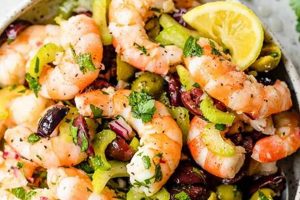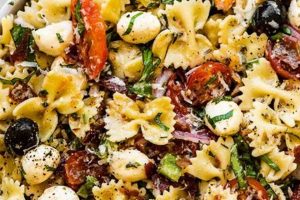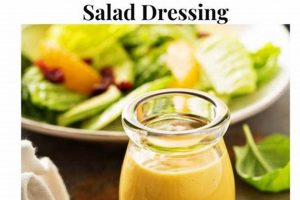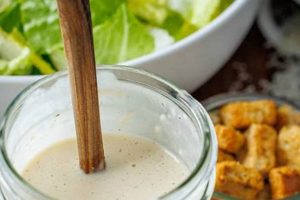A creamy emulsion typically combines minced garlic, grated Parmesan cheese, mayonnaise, olive oil, lemon juice, and seasonings. Variations may include Dijon mustard, Worcestershire sauce, anchovy paste, or different herbs like oregano or parsley. This dressing complements various salads, particularly those with romaine lettuce, croutons, and grilled chicken or shrimp.
The blend of pungent garlic, sharp Parmesan, and rich mayonnaise creates a flavor profile that enhances the overall salad experience. This classic dressing adds depth and complexity, transforming simple greens into a satisfying meal. Its popularity stems from its versatility and ease of preparation, making it a staple in many kitchens. While the precise origin is difficult to pinpoint, the combination of these ingredients likely emerged with the increasing popularity of Italian-American cuisine.
This exploration will delve further into the nuances of creating this dressing, covering topics such as ingredient selection, preparation techniques, variations, and ideal salad pairings. It will also provide insights into customizing the recipe to accommodate dietary restrictions and personal preferences.
Tips for an Exceptional Dressing
Creating a truly remarkable dressing involves attention to detail and a few key techniques. These tips offer guidance for elevating a basic preparation into something extraordinary.
Tip 1: Freshly Grated Parmesan: Pre-grated cheese often contains cellulose, which can hinder a smooth emulsion. Grating Parmesan directly from a block yields a superior texture and flavor.
Tip 2: Quality Olive Oil: Extra virgin olive oil contributes significantly to the dressing’s flavor profile. Opting for a high-quality oil enhances the overall taste.
Tip 3: Freshly Minced Garlic: Pre-minced garlic can sometimes have a bitter taste. Freshly minced garlic delivers a more vibrant, pungent flavor.
Tip 4: Lemon Juice for Brightness: Freshly squeezed lemon juice adds a necessary acidic element, balancing the richness of the other ingredients and brightening the overall flavor.
Tip 5: Emulsification Technique: Proper emulsification creates a smooth, creamy texture. Gradually whisk the oil into the other ingredients to prevent separation.
Tip 6: Seasoning Adjustment: Taste and adjust seasoning as needed. Salt and freshly ground black pepper enhance the flavors of the other components. A pinch of red pepper flakes can add a touch of heat.
Tip 7: Resting Period: Allowing the dressing to rest for at least 30 minutes in the refrigerator allows the flavors to meld and deepen.
By following these tips, one can achieve a dressing that is both flavorful and well-balanced, significantly enhancing any salad. This attention to detail elevates the dining experience.
These techniques provide a strong foundation for crafting exceptional dressings. The following section will offer further guidance on variations and pairing suggestions.
1. Ingredients
The quality and balance of ingredients directly impact the final flavor profile of a garlic parmesan salad dressing. Careful selection and proper handling of each component are essential for a successful outcome. This section explores key ingredients and their contributions to the overall taste and texture.
- Garlic:
Garlic forms the foundation of this dressing. Freshly minced garlic provides the most pungent and desirable flavor. Roasting the garlic before mincing mellows its intensity and adds a subtly sweet note. The amount of garlic used can be adjusted to suit individual preferences.
- Parmesan Cheese:
Parmesan cheese contributes a salty, umami richness. Freshly grated Parmesan is preferred, as pre-grated versions often contain cellulose which can hinder the emulsion process. The quality of the Parmesan directly influences the dressing’s overall depth of flavor.
- Mayonnaise:
Mayonnaise acts as the emulsifying agent, binding the ingredients together and creating a creamy texture. Full-fat mayonnaise provides the richest flavor and best emulsification. Alternatives, such as Greek yogurt or light mayonnaise, can be used for a lighter dressing, but may compromise texture.
- Acid:
An acidic element balances the richness of the other ingredients. Freshly squeezed lemon juice is most commonly used, providing brightness and a citrusy note. Alternatively, white wine vinegar or red wine vinegar can add complexity. The acid also contributes to the preservation of the dressing.
The interplay of these core ingredients defines the character of the dressing. Adjusting the proportions allows for customization, creating variations that range from intensely garlicky to subtly cheesy, each offering a unique flavor experience. Consideration of ingredient quality and their interactions is paramount for a balanced and delicious result.
2. Preparation
Preparation significantly impacts the final quality of a garlic parmesan salad dressing. Methodical preparation ensures optimal flavor development and a desirable texture. This stage encompasses several crucial steps, each contributing to the overall success of the recipe.
Mincing the garlic: Finely mincing the garlic maximizes its flavor dispersion throughout the dressing. Larger pieces can result in an uneven flavor distribution and a less pleasant textural experience. Alternatively, pressing the garlic creates a paste, yielding a more intense garlic flavor.
Grating the Parmesan: Freshly grated Parmesan cheese melts more readily into the dressing, contributing to a smoother, more cohesive texture and a richer flavor compared to pre-grated alternatives. The fineness of the grating can also be adjusted to influence the texture of the final product.
Emulsification: Careful emulsification is critical for preventing separation and achieving the desired creamy consistency. Slowly whisking the oil into the other ingredients, or using a blender or food processor, creates a stable emulsion that binds the components together effectively.
Resting period: Allowing the dressing to rest after preparation, preferably refrigerated for at least 30 minutes, allows the flavors to meld and deepen, resulting in a more balanced and nuanced taste profile. This step is essential for maximizing the synergy between the ingredients.
Overlooking these preparatory steps can result in a dressing with a less desirable texture, uneven flavor distribution, and reduced overall quality. Careful attention to these details ensures a harmonious blend of flavors and a creamy, emulsified dressing that complements a variety of salads and dishes.
3. Emulsification
Emulsification plays a critical role in the creation of a successful garlic parmesan salad dressing. It is the process of combining two immiscible liquids, typically oil and water-based ingredients, into a stable mixture. In this context, emulsification creates the desired creamy texture and prevents the dressing from separating into its individual components. A proper emulsion ensures a cohesive and visually appealing dressing that evenly coats salad ingredients.
- The Role of Mayonnaise:
Mayonnaise acts as the primary emulsifying agent in garlic parmesan dressing. Its composition of oil, egg yolks (containing lecithin), and acid creates a stable emulsion by allowing the oil and water-based ingredients (like lemon juice or vinegar) to combine and remain dispersed. The lecithin in egg yolks acts as a natural emulsifier, surrounding oil droplets and allowing them to suspend in the water-based solution.
- Whisking Technique:
The method of incorporating the oil into the other ingredients significantly impacts emulsion stability. Slow, gradual addition of the oil while whisking vigorously allows the emulsifier (mayonnaise) to effectively coat the oil droplets and prevent them from coalescing. This creates a smooth, uniform texture. Overly rapid addition of oil can overwhelm the emulsifier and lead to separation.
- Impact of Acid:
The presence of an acid, such as lemon juice or vinegar, is crucial for both flavor and emulsification. The acid helps to stabilize the emulsion by altering the pH and enhancing the emulsifier’s effectiveness. Furthermore, the acid contributes to the overall taste profile, balancing the richness of the other ingredients and providing brightness.
- Temperature Considerations:
Temperature can affect emulsion stability. Extreme temperatures can cause the emulsion to break, leading to separation. Room temperature ingredients are typically ideal for creating a stable emulsion. Refrigeration after preparation further stabilizes the dressing and allows the flavors to meld.
A well-executed emulsion is fundamental to a high-quality garlic parmesan dressing. It creates the desired creamy texture, prevents separation, and ensures that the flavors are evenly distributed throughout the dressing. Understanding the principles of emulsification allows for greater control over the final product, leading to a more satisfying culinary experience.
4. Flavor Balance
Flavor balance is paramount in a successful garlic parmesan salad dressing recipe. It represents the harmonious interplay of key taste componentsprimarily saltiness, richness, acidity, and pungencycreating a cohesive and palatable experience. A well-balanced dressing avoids any single flavor dominating, allowing the nuanced characteristics of each ingredient to shine through. This section explores the essential facets of flavor balance in this specific context.
- Saltiness from Parmesan:
Parmesan cheese provides the primary source of saltiness. The quantity used directly impacts the overall salt level of the dressing. Too much Parmesan can create an overwhelmingly salty flavor, while too little can leave the dressing bland. The inherent saltiness of the cheese must be carefully considered in relation to the other ingredients.
- Richness from Mayonnaise and Oil:
Mayonnaise and olive oil contribute richness and creaminess. Full-fat mayonnaise offers a more luxurious mouthfeel, while olive oil adds a subtle fruity or peppery note depending on the variety. Balancing these rich elements with brighter flavors prevents the dressing from becoming overly heavy or cloying.
- Acidity as a Counterpoint:
Acidity, typically from lemon juice or vinegar, plays a crucial role in cutting through the richness of the mayonnaise and oil. It provides a bright, refreshing counterpoint to the savory elements, preventing the dressing from feeling too dense. The level of acidity should be carefully calibrated to complement the other flavors without becoming overly tart.
- Pungency of Garlic:
Garlic provides the characteristic pungent note. The amount used, and whether it is raw or roasted, significantly influences the intensity of this flavor. Careful consideration must be given to balancing the pungency of the garlic with the other flavor components to avoid an overpowering garlic taste. Raw garlic delivers a sharper, more assertive flavor, while roasted garlic offers a mellower, sweeter alternative.
Achieving optimal flavor balance requires careful attention to the proportions and interplay of these elements. A harmonious blend of saltiness, richness, acidity, and pungency elevates the garlic parmesan salad dressing, transforming it from a simple condiment to a complex and flavorful addition to any salad.
5. Serving Suggestions
Serving suggestions offer practical guidance on maximizing the enjoyment of garlic parmesan salad dressing. The versatility of this dressing allows for a wide range of applications beyond the traditional Caesar salad. Understanding these pairings enhances culinary creativity and provides a broader appreciation for the dressing’s potential. Exploring various serving suggestions demonstrates how this classic dressing can elevate diverse dishes and flavor profiles.
- Classic Caesar Salad:
The quintessential pairing, garlic parmesan dressing forms the heart of a classic Caesar salad. The creamy dressing complements crisp romaine lettuce, crunchy croutons, and salty Parmesan shavings. The dressing’s richness balances the other components, creating a harmonious and satisfying combination. Addition of grilled chicken or shrimp further enhances the protein content and overall flavor profile.
- Grilled or Roasted Vegetables:
Garlic parmesan dressing enhances the flavor of grilled or roasted vegetables, adding a creamy, savory counterpoint to their natural sweetness. Vegetables such as asparagus, broccoli, zucchini, and bell peppers benefit from the dressing’s richness. The dressing can be used as a marinade before grilling or as a finishing drizzle after roasting. This application extends beyond salads, showcasing the dressing’s versatility.
- Pasta Salad:
Incorporating garlic parmesan dressing into pasta salad adds a creamy, flavorful dimension. The dressing coats the pasta evenly, providing a cohesive element that binds the other ingredients together. This application works well with a variety of pasta shapes and ingredients, such as vegetables, cheeses, and proteins. The dressing enhances the overall flavor profile and adds a touch of richness.
- Sandwich Spread:
Garlic parmesan dressing can be used as a flavorful spread for sandwiches and wraps. It adds a creamy, savory element that complements various fillings, from grilled chicken and vegetables to deli meats and cheeses. This unconventional use highlights the dressing’s adaptability and its potential beyond traditional salad applications.
These serving suggestions demonstrate the versatility of garlic parmesan salad dressing. Its ability to complement a variety of ingredients and dishes highlights its adaptability and enduring appeal. From the classic Caesar salad to more innovative applications, this dressing provides a rich, flavorful enhancement to diverse culinary creations. Experimentation with different pairings can further expand its potential and lead to exciting new flavor combinations.
Frequently Asked Questions
This section addresses common inquiries regarding the preparation and use of garlic parmesan salad dressing, offering practical solutions and clarifying potential points of confusion.
Question 1: How long can garlic parmesan salad dressing be stored?
Properly stored in an airtight container in the refrigerator, the dressing typically remains fresh for up to five days. Spoilage signs include a sour odor, discoloration, or mold growth.
Question 2: Can the dressing be made ahead of time?
Preparing the dressing in advance is recommended, as it allows the flavors to meld and deepen. Ideally, prepare the dressing at least 30 minutes prior to serving, or up to two days ahead, storing it in the refrigerator.
Question 3: Can low-fat ingredients be substituted?
Substituting low-fat mayonnaise or Greek yogurt for full-fat mayonnaise may result in a thinner consistency and potentially compromise the emulsion’s stability. Flavor adjustments might be necessary to compensate for the reduced richness.
Question 4: How can the intensity of the garlic flavor be adjusted?
Roasting the garlic prior to mincing mellows its pungency, resulting in a sweeter, less assertive garlic flavor. Alternatively, reducing the amount of raw garlic used directly controls the intensity of the garlic note.
Question 5: What can be done if the dressing separates?
Whisking vigorously or blending the separated dressing often re-emulsifies the ingredients. Adding a small amount of additional mayonnaise or a teaspoon of warm water while whisking can also help restore the emulsion.
Question 6: Beyond salads, what other uses are there for this dressing?
The dressing’s versatility extends beyond salads. It serves as a marinade for vegetables or proteins prior to grilling, a dipping sauce for raw vegetables or chips, a spread for sandwiches or wraps, or a flavorful topping for baked potatoes.
Understanding these frequently asked questions assists in creating and utilizing garlic parmesan salad dressing successfully. Attention to these details ensures a consistently delicious and enjoyable culinary experience.
The following section will provide a concise conclusion to this exploration of garlic parmesan salad dressing.
Conclusion
Exploration of garlic parmesan salad dressing recipes reveals a nuanced interplay of ingredients, techniques, and flavor profiles. From ingredient selection and preparation methods to emulsification and flavor balance, each step contributes significantly to the final product. Understanding the core componentsgarlic, Parmesan cheese, mayonnaise, and acidand their interactions is fundamental to achieving a harmonious and flavorful dressing. Proper emulsification ensures a creamy, stable texture, while careful attention to flavor balance prevents any single element from dominating. Furthermore, the dressing’s versatility extends beyond traditional salad applications, offering potential in marinades, dips, spreads, and more.
Culinary exploration often reveals unexpected depths in seemingly simple recipes. Garlic parmesan salad dressing, while seemingly straightforward, offers a rich tapestry of flavor possibilities. Continued experimentation with ingredient variations and applications promises further culinary discoveries and a deeper appreciation for this classic dressing.






